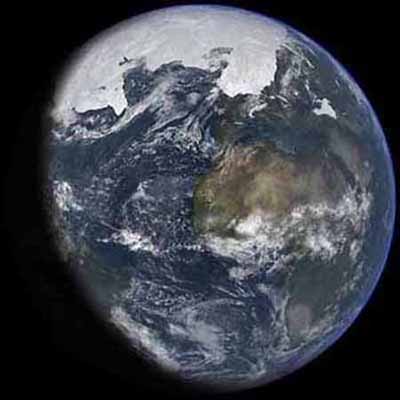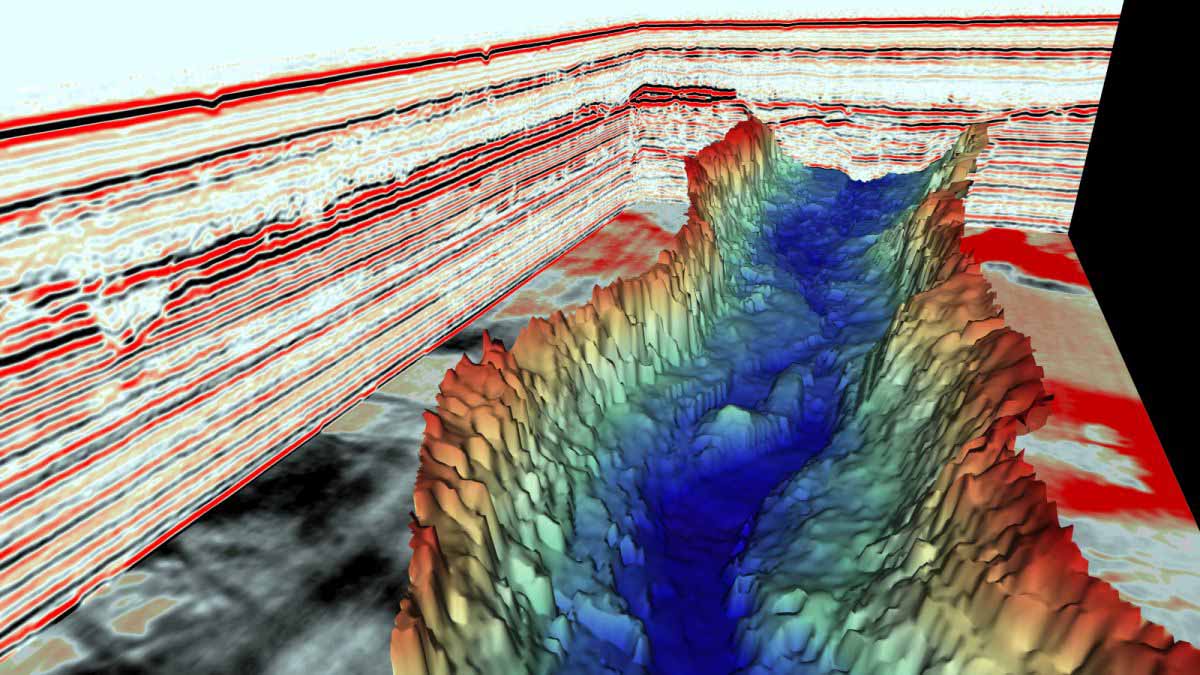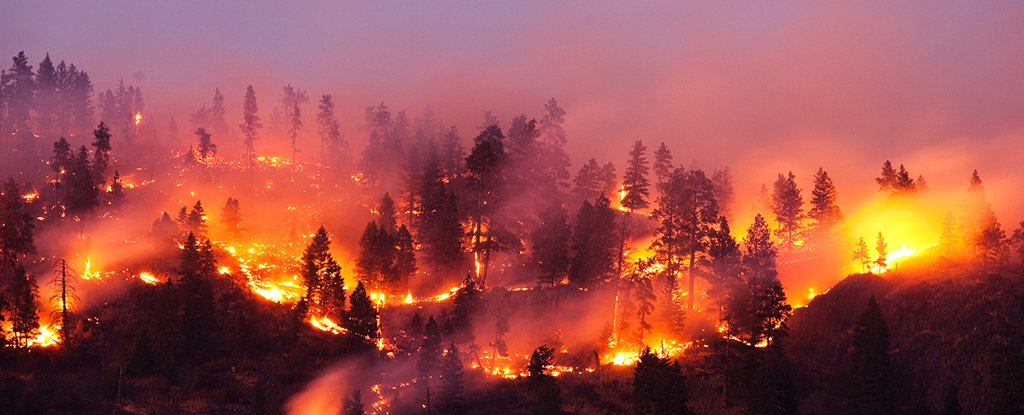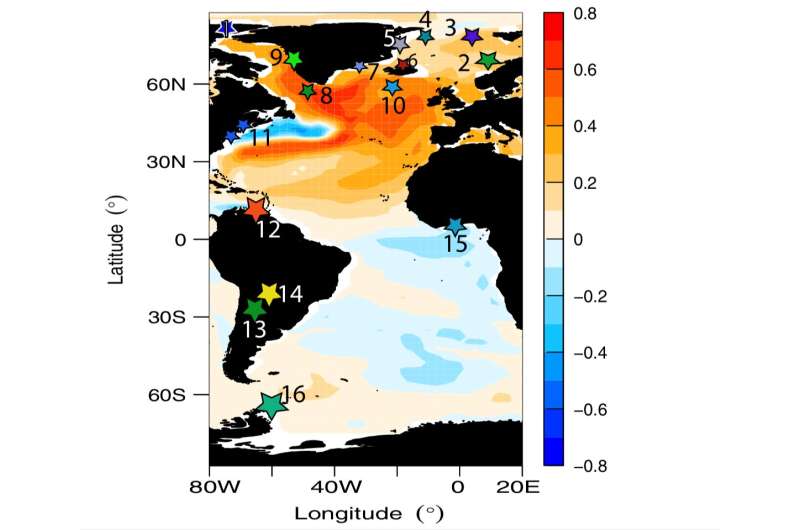

An ice age is a period of long-term downturn in the temperature of Earth's climate, resulting in an expansion of the continental ice sheets, polar ice sheets and mountain glaciers ("glaciation").
Glaciologically - Ice age is often used to mean a period of ice sheets in the northern and southern hemispheres; by this definition we are still in an ice age (because the Greenland and Antarctic ice sheets still exist).
More colloquially, when speaking of the last few million years, ice age is used to refer to colder periods with extensive ice sheets over the North American and Eurasian continents: in this sense, the last ice age ended about 10,000 years ago.
Many glacial periods have occurred during the last few million years, initially at 40,000-year frequency but more recently at 100,000-year frequencies. These are the best studied. There have been four major ice ages in the further past.
Origin of ice age theory
The idea that, in the past, glaciers had been far more extensive was folk knowledge in some alpine regions of Europe (Imbrie and Imbrie, p25, quote a woodcutter telling Jean de Charpentier of the former extent of the Swiss Grimsel glacier). No single person invented the idea.
Between 1825 and 1833, Charpentier assembled evidence in support of the concept. In 1836 Charpentier convinced Louis Agassiz of the theory, and Agassiz published it in his book Etude sur les glaciers (Study of Glaciers) of 1840.
At this early stage of knowledge, what was being studied were the glacial periods within the past few hundred thousand years, during the current ice age. The existence of ancient ice ages was as yet unsuspected.
The earliest hypothesized ice age is believed to have occurred around 2.7 to 2.3 billion (109) years ago during the early Proterozoic Age.
Snowball Earth
The cause of ice ages remains controversial for both the large-scale ice age periods and the smaller ebb and flow of glacial/interglacial periods within an ice age.
The general consensus is that it is a combination of up to three different factors: atmospheric composition (particularly the fraction of CO2 and methane), changes in the Earth's orbit around the Sun known as Milankovitch cycles (and possibly the Sun's orbit around the galaxy), and the arrangement of the continents.
An abundance of land within the Arctic and Antarctic Circles appears to be a necessity for an ice age, probably because the landmasses provide space on which snow and ice can accumulate during cooler times and thus trigger positive feedback processes like albedo changes. The Earth's orbit does not have a great effect on the long-term causation of ice ages, but does seem to dictate the pattern of multiple freezings and thawings that take place within the current ice age. The complex pattern of changes in Earth's orbit and the change of albedo may influence the occurrence of glacial and interglacial phases - this was first explained by the theory of Milutin Milankovic.
The present ice ages are the most studied and best understood, particularly the last 400,000 years, since this is the period covered by ice cores that record atmospheric composition and proxies for temperature and ice volume. Within this period, the match of glacial/interglacial frequencies to the Milankovic orbital forcing periods is so good that orbital forcing is the generally accepted explanation.
The combined effects of the changing distance to the sun, the precession of the Earth's axis, and the changing tilt of the Earth's axis can change and significantly redistribute the sunlight received by the Earth. Of particular importance are changes in the tilt of the Earth's axis, which impact the intensity of seasons. For example, the amount of solar influx in July at 65 degrees north latitude is calculated to vary by as much as 25% (from 400 W/m2 to 500 W/m2, see graph at). It is widely believed that ice sheets advance when summers become too mild to melt all of the accumulated snowfall from the previous winter. Some workers believe that the strength of the orbital forcing appears to be too small to trigger glaciations, but feedback mechanisms like CO2 may explain this mismatch.
While Milankovic forcing predicts that cyclic changes in the Earth's orbital parameters can be expressed in the glaciation record, additional explanations are necessary to explain which cycles are observed to be most important in the timing of glacial/interglacial periods. In particular, during the last 800 thousand years, the dominant inter/glacial oscillation has been 100 thousand years, which corresponds to changes in Earth's eccentricity and orbital inclination, and yet is by far the weakest of the three frequencies predicted by Milankovic.
During the period 3.0 - 0.8 million years ago, the dominant pattern of glaciation corresponded to the 41 thousand year period of changes in Earth's obliquity (tilt of the axis). The reasons for preferring one frequency to another are poorly understood and an active area of current research, but the answer probably relates to some form of resonance in the Earth's climate system.
The "traditional" Milankovitch explanation struggles to explain the dominance of the 100,000-year cycle over the last 8 cycles. Richard A. Muller and Gordon J. MacDonald and others have pointed out that those calculations are for a two-dimensional orbit of Earth but the three-dimensional orbit also has a 100 thousand year cycle of orbital inclination. They proposed that these variations in orbital inclination lead to variations in insolation, as the earth moves in and out of known dust bands in the solar system. Although this is a different mechanism to the traditional view, the "predicted" periods over the last 400,000 years are nearly the same.
Another worker, Ruddiman has suggested a plausible model that explains the 100,000 cycle by the modulating effect of eccentricity (weak 100,000 year cycle) on precession (23,000 year cycle) combined with greenhouse gas feedbacks in the 41,000 and 23,000-year cycles. Yet another theory has been advanced by Peter Huybers who argued that the 41,000-year cycle has always been dominant, but that the Earth has entered a mode of climate behavior where only the 2nd or 3rd cycle triggers an ice age. This would imply that the 100,000-year periodicity is really an illusion created by averaging together cycles lasting 80 and 120 thousand years. This theory is consistent with the existing uncertainties in dating, but not widely accepted at present.
During the most recent North American glaciation, the Wisconsin glaciation (70,000 to 10,000 years ago), ice sheets extended to about 45 degrees north latitude.
This Wisconsinian glaciation left widespread impacts on the North American landscape. The Great Lakes and the Finger Lakes were carved by ice deepening old valleys. Most of the lakes in Minnesota and Wisconsin were gouged out by glaciers and later filled with glacial meltwaters.
The old Teays River drainage system was radically altered and largely reshaped into the Ohio River drainage system. Other rivers were dammed and diverted to new channels, such as the Niagara, which formed a dramatic waterfall and gorge, when the waterflow encountered a limestone escarpment. Another similar waterfall near Syracuse, New York is now dry.
Long Island was formed from glacial till, and the watersheds of Canada were so severely disrupted that they are still sorting themselves out - the plethora of lakes on the Canadian Shield in northern Canada can be almost entirely attributed to the action of the ice.
As the ice retreated and the rock dust dried, winds carried the material hundreds of miles, forming beds of loess many dozens of feet thick in the Missouri Valley. Isostatic rebound continues to reshape the Great Lakes and other areas formerly under the weight of the ice sheets.
The Driftless Zone, around the junction of Wisconsin, Minnesota, and Iowa, was not covered by glaciers.
There have been four major periods of glaciation in the Earth's past. The first, and possibly most severe, may have occurred from 800 Ma to 600 Ma (million years ago, the late Proterozoic Age) and it has been suggested that it produced a "Snowball Earth" in which the earth iced over completely. It has been suggested also that the end of this cold period was responsible for the subsequent Cambrian Explosion, a time of rapid diversification of multicelled life during the Cambrian era. However, this theory is recent and controversial.
A minor series of glaciations occurred from 460 Ma to 430 Ma. There were extensive glaciations from 350 to 250 Ma. The present Pleistocene ice age has seen more or less extensive glaciation on 40,000 and later, 100,000 year cycles. The last glacial period ended about 10,000 years ago.

Neanderthals

 "
"
We exist in a simulated reality. What appears as the end of One Age caused by an "Ice Age" is in fact the simulation rebooting while the consciousness grids that create the illusion appear to be paused (frozen) in time.
Research reveals reality of puberty for Ice Age teens from 25,000 years ago PhysOrg - September 12, 2024
New research shows Ice Age teens from 25,000 years ago went through similar puberty stages as modern-day adolescents. A study found in the bones of 13 ancient humans between 10 and 20 years old is evidence of puberty stages.
What Food Did Neanderthals Eat To Survive In The Ice Age? IFL Science - September 11, 2024
Neanderthals emerged in Eurasia as far back as 400,000 years ago, long before Homo sapiens arrived, and lived until around 40,000 years ago. Neanderthals and other prehistoric humans have a reputation for being bloodthirsty brutes, existing on a diet of megafauna meat and the flesh of their enemies. But it wasnÕt just flame-grilled scraps of mammoth on the menu. A wealth of evidence shows that Neanderthals had a taste for meat, but also understood the value of fine seafood and even vegetarian fare. Some populations, in fact, ate an entirely plant-based diet.
'Death throes' of ancient ice sheets carved hidden valleys below the seafloor. The subterranean structures could provide clues about how modern ice sheets will react to climate change. Live Science - October 8, 2022

Hidden valleys buried beneath the ocean bottom in the North Sea were rapidly carved out during the "death throes" of an ancient ice sheet toward the end of the last ice age around 20,000 years ago, a new study shows. The surprising subterranean structures could yield clues as to how modern ice sheets will react to rapid warming caused by climate change, researchers say.
The buried structures, known as tunnel valleys, are massive underground ravines that were etched into the ancient seafloor by meltwater that drained into channels underneath the ice sheets. The immense weight of the rapidly melting slabs of ice forced the flowing water to cut deep canyons into the seafloor; those channels have since been covered by hundreds of meters of sediment buildup. Tunnel valleys can measure up to 93 miles (150 kilometers) long, 3.7 miles (6 km) wide and 1,640 feet (500 meters) deep, according to a statement by researchers (opens in new tab).
Clams Tell Us Why Earth Tipped Into a Mini Ice Age Hundreds of Years Ago Science Alert - September 15, 2022

Similar to the rings of a tree, the growth bands on their shells hold crucial information on the environment and how it has changed throughout the years. Like the lines of a diary, these intricate passages can be teased apart and read by scientists centuries after they were first 'written' down. In fact, the ancestors of clams have been laying down passages in the mineral calcite for more than five hundred million years, nearly three hundred million years before the dinosaurs showed up, giving us an unprecedented window into past climates. Now, these ancient archives are issuing a stark warning. A new reading of three bivalve records from the North Icelandic shelf has revealed a potentially dangerous tipping point in Earth's climate.
13,000 Years Ago, a Firestorm Covered 10% of Earth's Surface, Triggering an Ice Age Science Alert - February 7, 2022

At a point some 12,800 years ago, a tenth of Earth's surface suddenly became covered in roaring fires. The firestorm rivaled the one that wiped out the dinosaurs, and it was likely caused by fragments of a comet that would have measured around 100 kilometers (62 miles) across. As dust clouds smothered Earth, they kicked off a mini ice age that kept the planet cool for another thousand years, just as it was emerging from 100,000 years of being covered in glaciers. Once the fires burned out, life could start again.
Little Ice Age Wikipedia

Winter is coming: Researchers uncover the surprising cause of the Little Ice Age. The answer, we now know, is a paradox: warming PhysOrg - December 16, 2021
The Little Ice Age was one of the coldest periods of the past 10,000 years, a period of cooling that was particularly pronounced in the North Atlantic region. This cold spell, whose precise timeline scholars debate, but which seems to have set in around 600 years ago, was responsible for crop failures, famines and pandemics throughout Europe, resulting in misery and death for millions. To date, the mechanisms that led to this harsh climate state have remained inconclusive.
How cold was the ice age? Researchers now know PhysOrg - August 26, 2020
A University of Arizona-led team has nailed down the temperature of the last ice age - the Last Glacial Maximum of 20,000 years ago - to about 46 degrees Fahrenheit (7.8 C).
Ice Ages occur when tropical islands and continents collide Science Daily - April 12, 2019
Earth's steady state is warm and balmy, but half a dozen times over the past billion years, the planet developed ice caps and glaciers. Researchers have now amassed evidence that these cold snaps occurred when tectonic activity propelled continents headlong into volcanic island arcs in the tropics, uplifting ophiolites that rapidly absorbed carbon dioxide, cooling Earth. Once collisions stopped, CO2 again built up from volcanic eruptions and a runaway greenhouse effect warmed the planet.
Melting ice sheets release tons of methane into the atmosphere, study finds PhysOrg - January 4, 2019
While some methane had been detected previously in Greenland ice cores and in an Antarctic Subglacial Lake, this is the first time that meltwaters produced in spring and summer in large ice sheet catchments have been reported to continuously flush out methane from the ice sheet bed to the atmosphere.
Video: An ice age lasting 115,000 years in two minutes PhysOrg - November 6, 2018
An international research team used a computer model to reconstruct the history of glaciation in the Alps, visualizing it in a two-minute computer animation. The simulation aims to enable a better understanding of the mechanisms of glaciation.
Unravelling the mystery of ice ages using ancient molecules PhysOrg - March 12, 2018
Researchers have revealed how sea ice has been contributing to the waxing and waning of ice sheets over the last million years. A new study has shown for the first time that ice ages, occurring every 100,000 years, are accompanied by a rapid build-up of sea ice in the Earth's oceans. Our planet's ice ages used to occur at intervals of every 40,000 years, which made sense to scientists as the Earth's seasons vary in a predictable way, with colder summers occurring at these intervals. However there was a point, about a million years ago, called the 'Mid-Pleistocene transition', in which the ice age intervals changed from every 40,000 years to every 100,000 years.
Ancient tectonic activity was trigger for ice ages, study says PhysOrg - April 20, 2016
For hundreds of millions of years, Earth's climate has remained on a fairly even keel, with some dramatic exceptions: Around 80 million years ago, the planet's temperature plummeted, along with carbon dioxide levels in the atmosphere. The Earth eventually recovered, only to swing back into the present-day ice age 50 million years ago. Now geologists at MIT have identified the likely cause of both ice ages, as well as a natural mechanism for carbon sequestration. Just prior to both periods, massive tectonic collisions took place near the Earth's equator - a tropical zone where rocks undergo heavy weathering due to frequent rain and other environmental conditions. This weathering involves chemical reactions that absorb a large amount of carbon dioxide from the atmosphere. The dramatic drawdown of carbon dioxide cooled the atmosphere, the new study suggests, and set the planet up for two ice ages, 80 million and 50 million years ago.
The last ice age PhysOrg - July 3, 2014
A recent study, led by Dr James Rae of the University of St Andrews, found that changes in ocean circulation in the North Pacific caused a massive 'burp' of CO2 to be released from the deep ocean into the atmosphere, helping to warm the planet sufficiently to trigger the end of the ice age. Previously, scientists have suggested that the Antarctic Ocean and North Atlantic were the only places likely to release deglacial CO2, due to their deep water formation. However, a change in rainfall over the North Pacific region, caused by the East Asian monsoon and the Westerly storm track, made the ocean surface saltier and less buoyant, allowing it to form deep water. This allowed CO2 stored in the deep Pacific to be released to the atmosphere, where it helped warm the planet and melt back the ice sheets that covered much of the Northern Hemisphere.
Why an Ice Age Occurs Every 100,000 Years: Climate and Feedback Effects Explained Science Daily - August 9, 2013
Science has struggled to explain fully why an ice age occurs every 100,000 years. As researchers now demonstrate based on a computer simulation, not only do variations in insolation play a key role, but also the mutual influence of glaciated continents and climate. Ice ages and warm periods have alternated fairly regularly in Earth's history: Earth's climate cools roughly every 100,000 years, with vast areas of North America, Europe and Asia being buried under thick ice sheets. Eventually, the pendulum swings back: it gets warmer and the ice masses melt. While geologists and climate physicists found solid evidence of this 100,000-year cycle in glacial moraines, marine sediments and arctic ice, until now they were unable to find a plausible explanation for it.
Ancient Reindeer Hunters Fished Ice Age Lakes Live Science - March 10, 2013
Scientists have unearthed six fishhooks, the oldest of which was made from a 19,000-year-old mammoth tusk. Hunters of ice age reindeer around 12,300 years ago likely left the fishhooks, along with mammal and fish bones, in an open field in what is now Wustermark, Germany. The fishhooks, which are the oldest found in Europe, suggests humans developed fishing tools earlier than previously thought, probably to catch fast-moving fish that appeared in lakes as the climate warmed.
Humble moss helped to cool Earth and spurred on life BBC - February 2, 2012
Primitive moss-like plants could have triggered the cooling of the Earth some 470 million years ago, say researchers. A study published in Nature Geoscience may help explain why temperatures gradually began to fall, culminating in a series of "mini ice ages". Until now it had been thought that the process of global cooling began 100 million years later, when larger plants and trees emerged. The simple plants' interactions with rocks are believed to be the cause. The humble moss has created the climate which we enjoy today.
Scientists to Unearth Ice Age Secrets from Preserved Tree Rings Science Daily - April 6, 2010
Oxford University is involved in a research project to unearth 30,000 year old climate records, before they are lost forever. The rings of preserved kauri trees, hidden in New Zealand's peat bogs, hold the secret to climate fluctuations spanning back to the end of the last Ice Age.